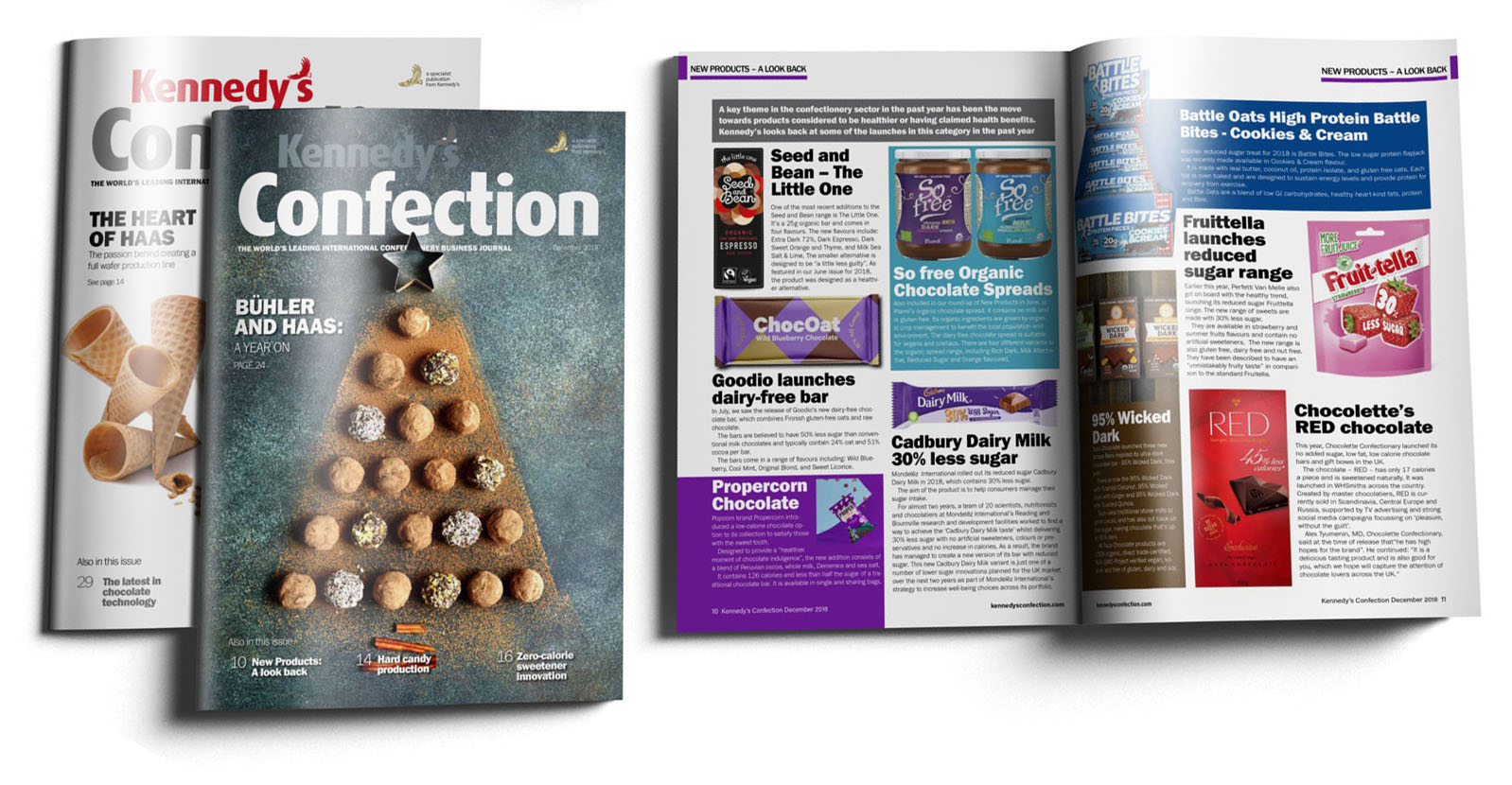Innovations in starch moulding technology are revolutionising the confectionery industry by providing versatile solutions that meet consumer demands for enticing and high-quality products.
In the fast-paced and ever-evolving confectionery industry, manufacturers are constantly seeking innovative solutions to meet consumer demands for enticing and high-quality confectionery products. One such technology that has gained significant attention is starch moulding. With its versatility and ability to create a wide range of confectionery delights, starch moulding has emerged as a powerful tool for B2B confectionery manufacturers. From gummies and jellies to marshmallows and fondant cremes, starch moulding technology offers a world of creative possibilities
Starch moulding technology offers a multitude of benefits to the B2B confectionery industry. Firstly, it provides manufacturers with exceptional versatility in product creation. Whether it’s crafting gummies with intricate designs, jellies with unique flavours, or centre-filled sweets with contrasting colours, starch moulding enables the production of diverse confectionery products that cater to consumer preferences and market trends. This versatility allows manufacturers to stay competitive in a rapidly evolving industry.
Another advantage of starch moulding technology is its efficiency in changeovers. With quick and efficient changeover capabilities, manufacturers can seamlessly switch between different product types or recipes, minimising downtime and maximising productivity. This flexibility is crucial in meeting varying market demands and maintaining a competitive edge. Starch moulding technology offers precise control over product shape, size, and texture. Manufacturers can achieve consistent and uniform results, ensuring product quality and enhancing consumer satisfaction. The ability to customise product characteristics allows for the creation of unique confectionery offerings, enabling manufacturers to differentiate themselves in a crowded marketplace.
Creating solutions for key challenges
On the other hand starch moulding technology also poses certain challenges to confectionery manufacturers. One significant challenge is ensuring hygienic design and compliance with industry standards. The production of functional jelly products, for instance, necessitates starch moulding equipment that meets the highest standards of hygienic design. Features like stainless-steel construction and easy accessibility for cleaning and maintenance are crucial for maintaining cleanliness and complying with regulations. Starch moulding can also be an energy-intensive process, particularly for products that require extensive drying times. Manufacturers must focus on optimising energy consumption and reducing environmental impact. Enhancing insulation, implementing precise process control, and utilising energy-efficient air treatment and distribution systems are key steps towards achieving sustainability and reducing the carbon footprint of starch moulding operations.
Significant advancements have been made in the industry, transforming the production of high-quality and innovative confectionery products. According to Edward Smagarinsky, Group Product Manager – Mogul at TNA Solutions, “Achieving consistent quality in confectionery products relies primarily on depositing technology.” The latest mogul technologies, such as the TNA mogul confectionery solution, offer a variety of pump modules that facilitate precise deposits of single-colour or multi-colour combinations, including side-by-side, centre-filled, foam, and starlight gummies. Smagarinsky adds, “These technologies utilise pumps with a single, flat valve to ensure continuous and accurate deposits, resulting in optimal product quality.”
Addressing the growing demand for hygienic design, particularly in the production of functional jelly products, Smagarinsky emphasises the importance of starch moulding equipment meeting the highest standards of hygienic design, with features such as stainless-steel construction and easy accessibility for cleaning and maintenance. He states, “Compliance with standards such as cGMP, CE quality standard, ISO, FDA, EU ATEX, US IECEx, and HAZLOC codes is also crucial.”
Another challenge is the need to accommodate rapid market growth while maintaining flexibility. The versatility of starch moulding technology allows for the production of a wide range of confectionery products, including gummies, jellies, marshmallows, fondant cremes, centre-in-shell, and liquorice. This flexibility enables manufacturers to cater to diverse consumer demands and expand their product offerings. Smagarinsky explains that the latest forté MHP 3 mogul from TNA addresses this challenge, stating, “This solution offers a streamlined design, minimal moving parts, and an integrated HMI, allowing manufacturers to achieve production capacities of up to 2,000 kg/h for gummy candy and up to 3,000 kg/h for pectin or starch-based recipes. This significant boost in productivity empowers confectionery producers to effectively meet market demands.”
Sustainability and waste reduction are also key considerations. Smagarinsky highlights that the latest mogul iteration from TNA minimises starch waste through improved insulation and system closure, reducing the need for cleaning with compressed air. He states, “This not only contributes to sustainability efforts but also results in cost savings for confectionery manufacturers.”
Efficient changeovers between different products or recipes are essential for maintaining production flexibility and minimising downtime. Manufacturers can optimise the changeover process to maximise productivity and meet varying market demands.
An integrated solution that combines all necessary components into one system is crucial for successful production. This includes various systems such as kitchen operations, starch conditioning, mogul feeding, depositing, stacking, finishing, distribution, packaging, and case packing. Having a fully integrated setup streamlines the production process, enhances efficiency, and reduces the chances of errors or inconsistencies.
Cesare Catelli, General Manager of Pinco SA, explains the significance of a constant and homogeneous airflow within the drying room for achieving the highest product quality and consistency. He states, “During our engineering process, particular attention is paid to the ducting design to avoid any potential dead spots, which could unbalance the airflow and therefore impact the final product quality.”
Catelli further highlights the importance of energy efficiency and minimising the carbon footprint. He explains, “The combination of heavy insulation of the entire drying room, precise process control, and a carefully designed air treatment and distribution system are key points to an energy-efficient process with a minimum CO2 footprint.”
To support customer productivity, Pinco SA focuses on optimising energy consumption and reducing drying times. Catelli adds, “Using the right drying room technology has a positive impact on the entire factory process flow, reduces downtimes, and guarantees reproducible product quality. Moreover, energy can be saved by a shorter drying process.”
Pinco SA constantly develops equipment and solutions to enhance the drying process and ensure customer satisfaction. Catelli says, “One of our latest developments in partnership with Agathon GmbH is the development of a data logging system for drying rooms. This system allows customers to obtain the full range of drying room process data and track every single process step, guaranteeing absolute product quality and enabling performance evaluations.”
The advancements in B2B confectionery starch moulding systems provide confectionery manufacturers with enhanced quality, increased productivity, sustainability, and innovation. Through the integration of cutting-edge technologies, manufacturers can meet evolving consumer demands and deliver exceptional confectionery products to the market. As Edward Smagarinsky concludes, “These advancements open up new possibilities for confectionery producers, allowing them to create products that captivate consumers and drive industry growth.”
What are starchless moulding systems used for?
Consumers today are more health-conscious and seek products that align with their wellness goals. Functional ingredients and nutraceuticals offer added health benefits beyond basic nutrition, such as boosting immunity, improving digestion, or providing antioxidant properties. Confectionery products fortified with these ingredients provide an opportunity for consumers to indulge in treats while also receiving some health benefits.
Confectionery products are often associated with convenience and on-the-go consumption. Incorporating functional ingredients and nutraceuticals into confectionery allows consumers to conveniently access the desired health benefits in a portable and enjoyable format. It offers a way to address specific health needs or preferences without compromising on taste or convenience.
Functional ingredients and nutraceuticals allow confectionery manufacturers to target specific consumer segments with specialised needs or preferences. For example, products fortified with vitamins and minerals may appeal to individuals seeking overall health and wellness. On the other hand, products containing ingredients like probiotics or fibre can target consumers looking for digestive health benefits. This targeted approach allows manufacturers to cater to specific niche markets and better meet consumer demands.
Starchless moulding systems have gained particular significance in these product types. Starchless moulding systems offer distinct advantages when incorporating nutraceuticals and functional ingredients into confectionery products. They help preserve ingredient efficacy, provide allergen-free and gluten-free options, enhance customisation possibilities, improve product stability, and align with sustainability and clean label preferences. With these benefits, starchless moulding systems empower manufacturers to create confectionery products that meet the growing demand for health-focused and functional treats.
Nutraceuticals and functional ingredients are often added to confectionery products to provide health benefits or specific functionalities. Starchless moulding systems are advantageous because they minimise exposure to heat and moisture during the moulding process, which helps preserve the efficacy of sensitive ingredients. Unlike starch-based moulding, where high temperatures and humidity can impact the stability and effectiveness of nutraceuticals and functional ingredients, starchless systems provide a gentle processing environment, ensuring optimal ingredient performance.
Nutraceuticals and functional ingredients are commonly used to address specific dietary needs or health concerns. Starchless moulding systems offer the advantage of being allergen-free and gluten-free, as they eliminate the need for starch derived from wheat or corn. This ensures that confectionery products fortified with nutraceuticals or functional ingredients can be safely consumed by individuals with specific dietary restrictions or allergies.
Nutraceuticals and functional ingredients often require precise dosing and formulation to achieve desired health benefits. Starchless moulding systems enable greater control over the deposition of these ingredients, allowing manufacturers to customise the distribution and concentration of nutraceuticals within the confectionery product. This level of customisation ensures that consumers receive the intended health benefits or functional properties in each serving.
Nutraceuticals and functional ingredients can be sensitive to environmental factors such as heat, moisture, and light, which can affect their stability and shelf life. Starchless moulding systems minimise exposure to these factors, providing improved product stability and prolonging the shelf life of confectionery products containing nutraceuticals and functional ingredients. This ensures that consumers receive products with optimal potency and efficacy throughout their intended shelf life.
And finally, the demand for sustainable and clean label products is on the rise. Starchless moulding systems align with these considerations as they eliminate the need for starch, reducing waste generation and simplifying the ingredient list. This resonates with consumers who seek transparent and environmentally friendly options in their nutraceutical and functional ingredient-enhanced confectionery products.
Looking to the future
Starch moulding technology will continue to benefit from technological advancements in automation, robotics, and digitalisation. Manufacturers will adopt advanced control systems, artificial intelligence, and machine learning algorithms to optimise production processes, enhance efficiency, and improve product quality. These advancements will lead to increased automation, reduced manual intervention, and improved precision in starch moulding operations.
The versatility of starch moulding technology will drive its expansion into new market segments beyond traditional confectionery. Industries such as pharmaceuticals and nutraceuticals may explore the use of starch moulding for the production of tablets, softgels, and cosmetic shapes. This diversification will open up new opportunities for starch moulding technology and its application in various industries.
And the implementation of Industry 4.0 principles, such as the Internet of Things (IoT), data analytics, and connectivity, will transform the starch moulding sector. Manufacturers will leverage real-time data collection and analysis to optimise production efficiency, improve quality control, and enable predictive maintenance. This digital integration will enable better traceability, supply chain management, and overall operational excellence in starch moulding processes.
In summary, the starch moulding sector is poised for continued growth and innovation in the coming years. With a focus on functional products, customisation, sustainability, technological advancements, diversification into new market segments, and the integration of Industry 4.0 principles, starch moulding technology will shape the future of confectionery production, catering to evolving consumer demands and industry trends.
Editorial contact:
Editor: Kiran Grewal kgrewal@kennedys.co.uk







